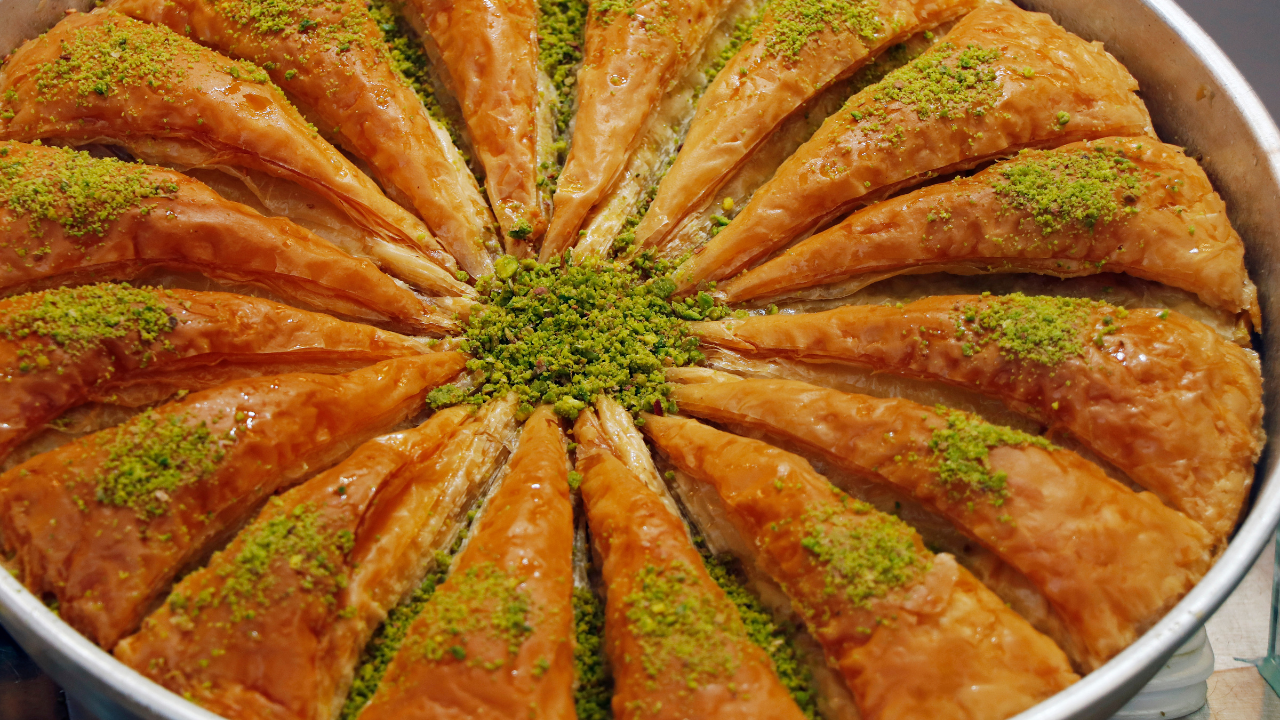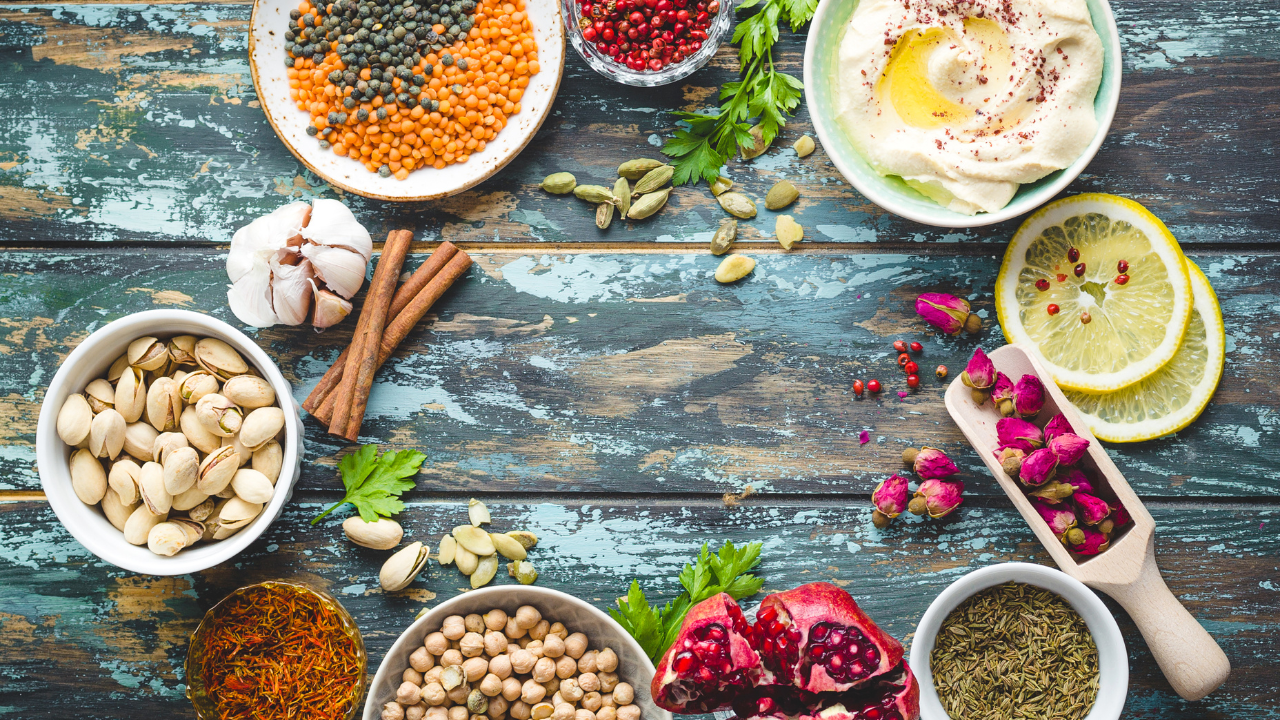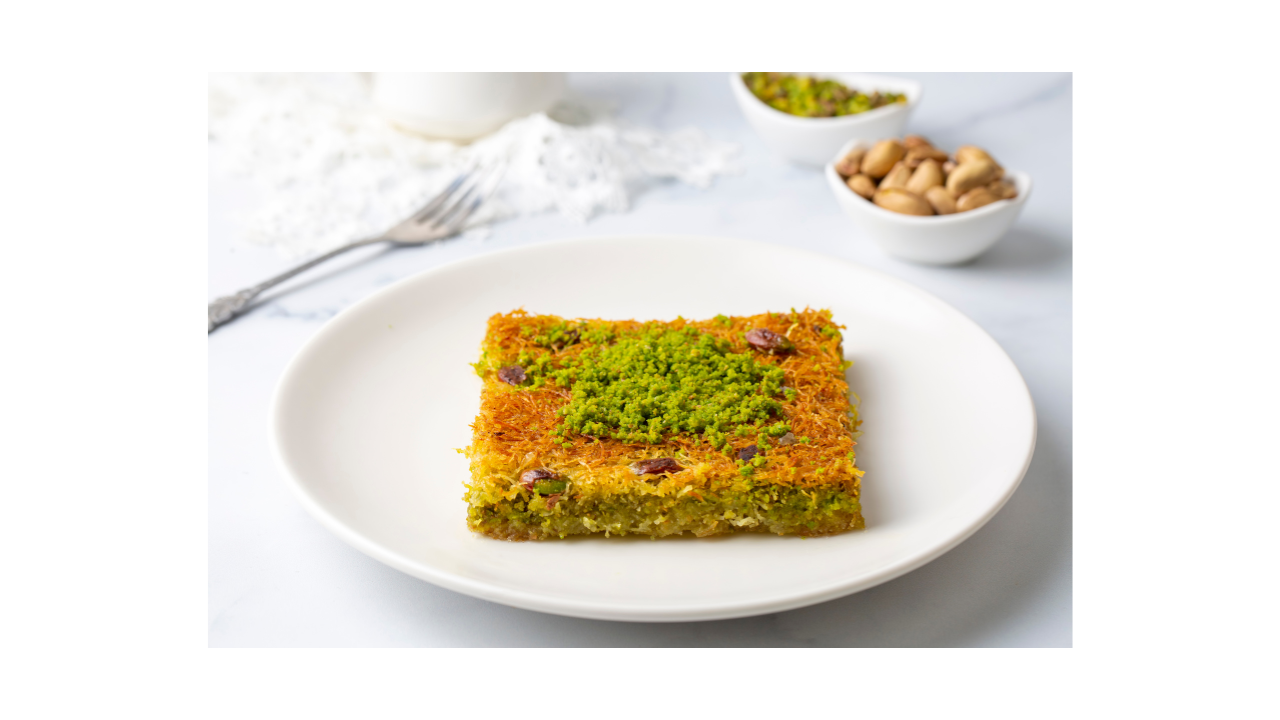Welcome to the delicious world of Middle Eastern kunafa, a classic dessert that entices palates with an ideal fusion of flavours and textures. Kunafa, a delicious pastry with Middle Eastern origins, combines layers of crispy semolina dough, a creamy centre, and a substantial amount of crunchy nuts, all drenched in sweet syrup to create an incredibly satisfying treat. This post will examine the fascinating background and provenance of kunafa, identify the key components required to make this delicious delicacy, give detailed cooking directions, and provide advice and alternative recipes to help you become an expert kunafa maker. Prepare yourself for a gastronomic adventure brimming with heritage, taste, and inventiveness as we explore the realm of Middle Eastern kunafa.
Table of Contents
ToggleAbout Middle Eastern Kunafa Dessert

The delicious dessert known as Middle Eastern kunafa has captured the palates of people all throughout the region. Kunafa is a real treat, with layers of delicate semolina, luscious cream, and crunchy nuts. Let’s explore the background, components, and methodical cooking of this tasty dessert.
History and Origins of Middle Eastern Kunafa
Kunafa has an intriguing culinary history. It is sometimes referred to as Knafeh or Kadaif. Its origins can be found in the Ottoman Empire, when it was a beloved confection during holidays and festivities. Kunafa became a staple of Middle Eastern feasts and family get-togethers as it expanded over time.
Ingredients Required for Middle Eastern Kunafa Recipe

To make the ideal Kunafa, assemble the following components:
Semolina, or Kunafa Dough:
The foundation of Kunafa is semolina. It absorbs the sweet syrup and adds a delicious crunch.Rich, clarified butter or ghee helps to bond the semolina layers and provides flavour.
Cream Filling:
Kunafa’s creamy layer is made from a sugar, milk, and cream blend.
Nuts:
Diced walnuts, almonds, or pistachios give a nutty flavour and texture.
Sugar-Syrup:
The dish is sweetened with a fragrant syrup made with sugar, water, and a tiny bit of lemon juice.
Step-by-Step Cooking Instructions for Middle Eastern Kunafa
Prepare the Kunafa Dough:
- Make the kunafa dough by combining semolina with ghee or melted butter until it forms coarse crumbs.
- To construct the bottom layer, press half of the dough into a baking dish that has been oiled.
Layer the Cream Filling:
- Evenly cover the dough layer with the cream mixture.
- Press the remaining semolina dough carefully on top.
Layer the Cream Filling:
- Evenly cover the dough layer with the cream mixture.
- Press the remaining semolina dough carefully on top.
Bake to Golden Perfection:
- Bake until a golden brown and crispy top, in a preheated oven.
Sweeten with Syrup:
- To sweeten, drizzle some warm sugar syrup over the heated kunafa and let it seep in.
Nut garnish:
- Add a fair amount of chopped nuts on top.
Tips for Perfect Middle Eastern Kunafa Preparation
Balance the Layers:
For a pleasing flavour, make sure the cream filling and semolina layers are distributed equally.
The Golden Brown Crust:
Watch the baking process to get that ideal shade of golden brown.
Serve Warm:
The best time to eat kunafa is right out of the oven, when the layers are crispy.
Variations and Customizations of Middle Eastern Kunafa

Kunafa is available in a variety of fascinating varieties, each with a distinct twist. Here are a few well-liked versions:
- Classic Ashta Kunafa: This is my favourite kind; it’s filled with ashta, a rich, silky custard. The creamy layer of ashta, which is produced from milk and cornflour, counterbalances the crisp crust.
- Cheese-Filled Kunafa: I’ve modified my mom’s original recipe by adding a layer of sweet cheese to appeal to both cheese lovers and traditionalists. The ashta is wonderfully complemented by the stretchy cheese.
- Nutty Kunafa: Some versions sandwich a variety of nuts—typically ground almonds or pistachios—between the layers. A delicious crunch and nutty flavour are added by the nuts.
Serving Suggestions and Presentation Ideas

Presenting Kunafa well is important. The following advice will help you enjoy dessert even more:
Individual Portions: Serve Kunafa in separate portions for a refined presentation. To make elegant servings, use tiny ramekins or dessert bowls.
Add rose petal garnish: Add some dried rose petals on top to create a fragrant and eye-catching display. The little scent makes the whole experience better.
Layered Presentation: To create an eye-catching dessert tower, arrange the kunafa in layers: pastry, custard and nuts. Pour plenty of syrup in between the layers.
Health Benefits and Nutritional Information of Middle Eastern Kunafa
Although kunafa is definitely rich, it has certain nutritional advantages:
Calcium: The custard made with milk gives you the necessary calcium for healthy bones and teeth.
Protein: Essential for the health of muscles, the ashta layer provides protein.
Healthy Fats: The traditional ingredient ghee has healthy fats that promote general wellbeing and brain function.
Recall that moderation is crucial. Savour every taste of kunafa as a delicious pleasure.
My Personal Experience with Middle Eastern Kunafa Dessert Recipe
My mother’s Kunafa was a highlight of family get-togethers when I was growing up. I will never forget the excitement I felt as mother took the golden-brown pastry out of the oven, the scent of the sweet syrup, and the first bite. Indulging in a romantic evening or commemorating noteworthy events, Kunafa offers solace and happiness. It’s a delightful reminder of Middle Eastern culinary history, a taste of tradition, and a link to bygone eras.
Conclusion
Finally, Middle Eastern Kunafa, with its exquisite blend of crispy, creamy, and nutty flavours in every bite, is a monument to the region’s rich culinary tradition. Kunafa is a delicious delight that may be savoured on special occasions or any day of the year, and it is a favourite among foodies all over the world. You can design a unique Kunafa artwork that expresses your creativity and preferences by following the detailed guide offered in this article. Bring happiness and gourmet delight to your table with the scent of freshly baked kunafa and the satisfaction that comes with a masterfully prepared dessert. Savour the customs and tastes of the Middle East with every delectable Kunafa piece.
FAQs
What is Kunafa from the Middle East?
A classic delicacy from the Middle East, kunafa is composed of layers of crispy semolina dough, creamy filling (such cheese or cream), crunchy almonds, and sweet syrup.
How is it can be made?
Middle Eastern Kunafa is made by layering thinly rolled or shredded semolina dough, sandwiching a creamy filling in between, baking until crispy and golden, and then soaking it in sweet syrup.
Which elements are essential to Middle Eastern kunafa?
Semolina, or shredded phyllo dough, cream or cheese for the filling, nuts (like almonds or pistachios), butter, sugar, and flavoring syrup (like rose water or orange blossom water) are the main ingredients of Middle Eastern Kunafa.
Can my Middle Eastern Kunafa be personalized?
Yes, you may add different nuts or dried fruits, change up the fillings, and try different flavored syrups to make your Middle Eastern kunafa unique to your tastes.
What are the guidelines for preparing the ideal kunafa from the Middle East?
Making sure the semolina layers are evenly crispy and not too dry, choosing a tasty filling, and soaking the dessert in the appropriate quantity of syrup to add sweetness without making it soggy are some recommendations for creating the ideal Middle Eastern kunafa.
How is kunafa from the Middle East served?
Middle Eastern kunafa is typically served warm or room temperature, either by itself as a dessert or with a dab of whipped cream or a scoop of ice cream on top.
Does consuming Middle Eastern kunafa provide any health benefits?
Middle Eastern kunafa is a tasty dessert, but because of its high sugar and fat content, it should only be consumed in moderation. Nevertheless, depending on the precise components used, it does offer some energy from the semolina and nutrients from the nuts.
What kinds of Kunafa are there in the Middle East?
Middle Eastern Kunafa comes in a variety of forms with fillings like cheese, cream, or a mix of the two. There are also differences in the kinds of nuts that are utilized and the syrup’s flavorings.
What is the background of Kunafa in the Middle East?
Variations of Middle Eastern Kunafa can be found throughout the Mediterranean and Middle East, and it has a long history spanning centuries.

Meet Misha Mehboob, a passionate food enthusiast and computer science student from Sargodha University. Misha’s culinary journey is fueled by her love for exploring new flavors and experimenting in the kitchen.
At CrispyEatHub, Misha shares her creative recipes and practical cooking tips to inspire fellow food lovers on their culinary adventures. From quick weeknight dinners to indulgent desserts, there’s something delicious for every palate.
Join Misha as she combines her love for food and technology to create mouthwatering dishes that delight the senses and bring people together. Let CrispyEatHub be your go-to resource for culinary inspiration and delicious recipes that make every meal memorable.

